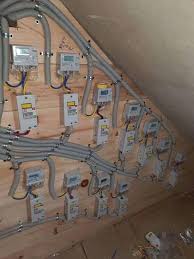The Basics of Commercial Electrical Installations
In commercial buildings, the wiring is much different than in residential homes. Most commercial wiring is protected inside conduits, which are big plastic or metal tubes. Commercial wires are covered with a thermoplastic, high-heat-resistant coating, which is much more durable than the thin wire used in the home. Conduit covers are also more effective at protecting the wiring from corrosive liquids and gases. This article will discuss the basics of commercial electrical installations.
Commercial electrical services are essential for a wide range of businesses. A skilled team of professionals is necessary to install the wiring in a commercial establishment. They will make sure to understand the needs of different businesses and provide solutions tailored to suit the location. Commercial electrical installations may include new wiring, rewiring, and emergency lighting. To learn more, contact a licensed electrician. This company can also provide you with preventive maintenance for the electrical system of your business.
Conductors are the wires that conduct electrical currents. These can be uncoated or coated. The type of conductor used depends on the desired electricity and the type of materials that the conductors are made of. A commercial electrician will decide on the type of conductors to use based on the amount of electricity the facility will need. In addition to the wires, the cables themselves will need some form of containment. In some cases, containment may consist of metal boxes or a special enclosure to keep them safe from the elements.
A commercial electrician will have to understand the unique design and purpose of a commercial project to choose the best way to install electrical systems. They will determine the best methods to install the wiring while protecting it from the harmful effects of moisture, heat, and age. In addition to these regulations, electricians will also need to consider the type of wire, as well as the type of sheathing. Some of the wirings will be set up in open spaces, which is why choosing the right wire is so important.
The type of outlets required depends on the size of the building and the floor occupancy. A commercial electrical installation is usually equipped with sockets and lights. Sockets and outlets are an essential part of any commercial electrical installation. Electrical outlets and sockets vary according to the building’s electrical system. In some cases, the electrician may upgrade the speed of the outlet through modifications in the electrical system. This can be a cost-saving measure that will benefit all parties.
If you are unsure of what type of electrical installation your building requires, consider hiring a full-service electrical company. These companies will be able to provide you with the necessary services, including the installation of energy-efficient lights. They will also be able to give you tips to keep your commercial property running smoothly. Commercial electrical installation companies will assess your building and offer a detailed estimate. When evaluating a potential electrical installation company, make sure to ask about the experience of the company you are considering.
The distribution panelboard is another important component of commercial electrical installations. It is a device that converts electricity from the grid into the various parts of the building. It also serves as a fuse or breaker. When choosing a distribution panelboard, make sure to select one with large wiring space, color labels, and easily-accessed door handles. A commercial service entrance is a point where grid electricity enters the building. This location may be an overhead wire connected to a utility pole or a trough with multiple switches. The wiring methods are based on the design of the building and its function.
Unlike residential homes, commercial buildings require more electricity than a single home. Because commercial buildings use more electricity, the wiring in commercial buildings must be three-phased. This allows for the even distribution of electricity across the wires and makes energy delivery more efficient. Commercial electrical wiring may need to be more than one phase because of the different devices used in the space. Often, this wiring is exposed to the public and is a safety issue.
